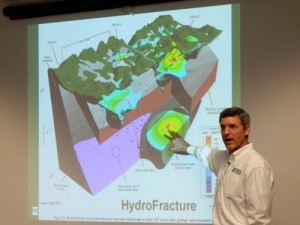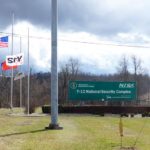
Daniel J. Goode, a research hydrologist for the U.S. Geological Survey, briefs members of the Oak Ridge Site Specific Advisory Board on a new groundwater strategy for the Oak Ridge Reservation.
The U.S. Department of Energy has agreed to spend $4.5 million during the next three years to study groundwater contamination on the Oak Ridge Reservation.
The reservation includes three federal sites—East Tennessee Technology Park, Oak Ridge National Laboratory, and Y-12 National Security Complex—that have been involved in missions ranging from scientific research to uranium enrichment to nuclear weapons work. That work has sometimes included the use of hazardous substances such as mercury and technetium-99, a slow-decaying radioactive metal.
The $4.5 million in funding will help implement a new groundwater strategy developed by DOE with help from the Tennessee Department of Environment and Conservation and the U.S. Environmental Protection Agency.
The strategy, which was presented to the Oak Ridge Site Specific Advisory Board in November, will help guide future cleanup decisions, said Sue Cange, deputy manager for environmental management in DOE’s Oak Ridge Office.
Officials said there is no cause for alarm, and the off-site risks from possible groundwater contamination aren’t significant enough to compel the EPA to require the Department of Energy to act.
“No one should be alarmed,†said Daniel J. Goode, a research hydrologist for the U.S. Geological Survey. “DOE is managing the site. It’s very complex. It’s very contaminated. But they are protecting the public. There is no crisis here.â€
But during a November briefing to the SSAB, Goode said there are questions about the potential migration of contaminated groundwater off the Oak Ridge Reservation through very limited, discrete waterways deep under ground.
The groundwater project team, which also included representatives from UCOR/RSI and SAIC, recommended a three-year off-site groundwater quality assessment focused on the southwest side of the Oak Ridge Reservation. Residential wells and springs could be sampled and their contents analyzed to determine if contaminants unique to the ORR are present and if there is a potential public health risk from DOE contaminants. The results could be evaluated to determine if more action is needed.
The groundwater strategy document said there have been recent sporadic, low-concentration detections of radionuclides and volatile organic compounds, or VOCs, in off-site sampling locations “downgradient†of the ORR.
The contaminants are at very low concentrations, but DOE has put in place some land-use restrictions and provided water to residents, Goode said. There are off-site monitoring wells in Melton Valley between Haw and Copper ridges, and they have detected contaminants that could have come for Oak Ridge.
“There are no known health impacts from contaminants detected off-site,†the strategy document said. “However, in order to minimize groundwater pumping that could draw DOE contaminants off-site, license agreements restricting groundwater use have been put in place for some residents in the area west of the Clinch River across from Melton Valley.â€
The strategy said a number of radionuclides and VOCs have been periodically detected at low levels in monitoring wells in Melton Valley southwest of ORNL. There have also been intermittent detections of metals and VOCs in off-site wells on the west side of the Clinch River, across from the reservation, and two detections of strontium-90 and technetium-99 have been observed, the report said.
But with the exception of a low VOC detection in one well in 2010, no known DOE contaminants in off-site wells across the Clinch River from Melton Valley have exceeded safe drinking water standards, Goode said. And that one compound was not detected in subsequent samples from the same well.
Detection of the contaminants doesn’t prove migration from the Oak Ridge Reservation, but there is a consensus that off-site migration is plausible, may have occurred, and needs investigation, Goode said.
Dave Adler of DOE-ORO said VOCs are not unique to Oak Ridge—they’re used for activities ranging from agriculture to racing—but technetium-99 is. The technetium-99 was found in a DOE sampling well and only after aggressive drilling that could have drawn contaminants into the well, Adler said.
Goode said the groundwater strategy could include a revival of state-of-the-art studies at the Oak Ridge Reservation that could include academic and government experts. That type of approach seems to be under way with respect to mercury, Goode said.
He said there are many data gaps regarding groundwater contamination because there has been little investigative work since the 1990s. Since the early 1990s, DOE has focused on remediation and monitoring and less on science, even though there have been scientific advances in characterization and modeling in the past two decades, Goode said.
The project team’s strategy document included a ranking of plumes on the Oak Ridge Reservation at ETTP, ORNL, and Y-12. They were ranked by pathway, hazard, toxicity, and longevity, among other things.
The top two plumes by what is known as a pathway score are contamination from undetermined sources on the southwest side of the reservation, southwest of ORNL’s main campus and near the Clinch River, and uranium in Maynardville limestone at Y-12. The third is S-3 Deep nitrate in the Maynardville limestone in Bear Creek Valley west of Y-12.
The top ranking by what is known as a total plume score—the final results were heavily weighted with the pathway score—is a hydrofracture disposal site south of ORNL where waste was injected between 700 to 1,000 feet underground with cement. That site had the highest hazard score.
Goode said the ORSSAB could consider recommending that DOE collect, review, and archive records associated with the hydrofracture disposal site to support long-term stewardship. He said that waste will be at that spot forever.
Communications with the public could be an important part of the groundwater work, Goode said.
For some time, regulators have wanted DOE to evaluate groundwater contamination and develop possible responses. Officials said the new groundwater strategy will include the implementation of more groundwater investigation to support ongoing efforts to manage groundwater resources associated with the Oak Ridge Reservation.
“This is a great example of us trying to be more collaborative with the environmental regulators,†said Michael T. Koentop, executive officer in DOE’s Oak Ridge Office of Environmental Management.
Read the groundwater strategy document here: ORSSAB Groundwater Report.
More information will be added as it becomes available.





Andrew Howe says
I realize this news and the study is mostly for the DOE facilities, but as a resident it raised questions for me.
Being the little digger I am, I attempted to find out just how separate and safe our drinking water is from internet research.
For the life of me, I cannot find where exactly we draw water from the Clinch to process for city drinking water. It’s supposedly 15 miles downriver of Norris Dam and a mile upstream from any DOE facility.
I know that most of the mercury-rich areas are on the west end of town and NOT a source for our drinking water, but since I also know streams on the east end have a history of contaminants (behind Big Lots), and those feed into Melton Lake, at a location that may well be upstream from the point where we draw our drinking water, I really want some assurances. I want to know where we get the water, where it travels to be cleaned, how close it travels to cruddy waters, etc. Full disclosure, in short. Show me a map of the system, show me where it comes close to other systems, etc.
Maybe the library has the info I need. I’ll try there tomorrow.
It’s great the Govt is going to spend a ton of money cleaning up there spills, but I’d love to see the expand their scope to include the actual town and our water supply.
You can find the annual H2O report online (http://www.oakridgetn.gov/images/uploads/Documents/Departments/PublicWorks/Water%20Quality/CCR2012.pdf) but it doesn’t report on mercury or other heavy metals. It needs to be more complete.
johnhuotari says
Andy,
I believe the city’s water intake is on the Clinch River east of ORNL headed to Clark Center Park. If you follow Scarboro Road across Bethel Valley Road, it turns into Pumphouse Road. A short ways past Bethel Valley Road, the main road goes right and turns into Bull Bluff Road and goes to Clark Center Park. Pumphouse Road goes straight and leads to the water intake, but the entrance is locked and gated. (I believe that’s DOE property managed by TWRA.)
You can find a diagram showing the location of the water intake in the city’s Capital Improvements Program on page VI-5 (that should be page 77): http://www.oakridgetn.gov/images/uploads/Documents/Departments/CommDev/Planning%20files/CIP/2014-2019%20Capital%20ImprovementProgram.pdf
Dave Smith says
I think this link will show a Google Maps’ view of the water intake station:
http://goo.gl/maps/h2KtD
If it’s any consolation, the COR intake is a couple of miles upstream from the west Knox County intake. I feel pretty sure that water above and below the DOE complexes is safe.
johnhuotari says
Thanks, Dave.
Andrew Howe says
Thanks, to both of you.
I realize I jumped the gun on my post and should’ve made phone calls first.
Sorry for being a prat. It probably won’t be the last time. It happens with the passionate LOL.
Tim McGhee says
First off, the study is being done on GROUNDWATER contamination, not surface waters like where the city draws its water supply. To the best of my recollection, there has never been any concern ever expressed regarding heavy metal or mercury contamination in Melton Hill Lake above the dam. The East Fork of Poplar Creek (the stream that runs behind Big Lots), flows all the way through town and empties into the Clinch River out around K-25, well below the Melton Hill Dam and a long way from the city’s water intake. All you need to do to figure that out is the ability to read a map. Maybe you should worry about runoff from the Bull Run Steam Plant or maybe what comes out of the Clinton sewage treatment plants which are above the city’s water intake. Better yet, maybe you should just drink bottled water….
Andrew Howe says
Gracias, Tim,
Well, I may be wrong about the direction of flow on that creek. I could’ve sworn it was flowing eastward and joining the little pond between Palisades Pkway and Meco Ln. I read maps like a champ, but none I found online indicate direction of water flow, so I had to go from memory.
I definitely worry about run-off from other polluters, too, and if the previous post is correct about our source location, I’m wary. Not that I don’t trust our treatment plants, but it’s a bit close to the res for me.
Groundwater becomes surface water, of course, somewhere along the line. I’m very glad the feds want to clean what they can for those organisms living downflow. I’m fairly well versed in karst hydrology, so I’m aware of the complexities of the sub-surface flow. When the recharge zones underground fill-up, contaminants don’t always simply flow the typical direction.
Actually, what started all this for us was a friend environmentalist who had concerns about mercury in the O.R. drinking water. Since I’ve been unable to find mercury tests in the hardware stores (lead yes, but other heavy metals, no) I guess I’ll have to call the EPA’s Safe Drinking Water Hotline at 800-426-4791.
Regardless, since we live in Oak Ridge, and people here worry about two main sources of contamination – mercury and rad – it seemed odd that those are not part of our annual water report. Since I’ve moved here I’ve been hearing residents say they fear the drinking water. The annual report is an excellent way to quell those fears if it provides data on those fears. When such an obvious solution exists and isn’t implemented, you get residents thinking the City is purposefully hiding that data in a CYA move. I’m not one of them, but this is yet another example of how public disclosure on a regular basis can totally change the perspectives of the populace.
Sam Shephard says
The only stream from the east end that has a history of contamination is
East Fork Poplar Creek. The ONE AND ONLY. It originates from a spring
in the Y-12 plant area, becomes contaminated from the Y-12 operations
and goes nowhere near Palisades Parkway and Meco Lane. Your map reading “skills” are deficient, as are your computer skills. A simple Google search turns up tons of information on the East Fork Poplar Creek situation like:
https://www.knoxnews.com/news/2011/dec/19/thanks-in-part-to-mercury-y-12-plant-has-most-in/
“In a remarkable sign of that recovery, Ryon’s team at Oak Ridge National
Laboratory recently discovered a tangerine darter about midway between
the point where East Fork leaves Y-12 and, 15 miles later, joins with
Poplar Creek.”
http://en.wikipedia.org/wiki/Poplar_Creek_%28Tennessee%29
“Poplar Creek is a tributary of the Clinch River in Anderson and Roane counties in East Tennessee. Draining a watershed area of more than 82 square miles (210 km2),[1] it enters the Clinch near the former K-25 site, a short distance downstream from the confluence of East Fork Poplar Creek, its largest tributary.”
As to people who “fear” the water, ignorance is a mighty powerful thing.
Andrew Howe says
Sam, you misunderstand the stream in question. It may well be a tributary of EFPC, but also may be a feeder into Melton Lake. Either is bad.
The small stream in the narrows by Jefferson Middle school and Home Depot either goes or comes from the east, mostly underground, so not on maps. This stream goes or comes from the west to around the junction of Warehouse Rd and Coal Yard Rd:
https://maps.google.com/maps?q=Meco+Lane,+Oak+Ridge,+TN&hl=en&ll=36.032648,-84.223823&spn=0.002696,0.003484&sll=35.969776,-84.295973&sspn=0.488477,0.891953&oq=meco+l&t=h&hnear=Meco+Ln,+Oak+Ridge,+Anderson,+Tennessee+37830&z=19
It’s there, its a flowing stream. It’s hot, and specifically heavy with mercury, according to my source. It’s not on google maps.
Next, a stream, running from the end of Belgrade Road, south of the rail tracks, can be seen on the following map:
http://www.outdoorknoxville.com/images-outdoors/map-Oak-Ridge-Greenways.pdf
and running to Melton Lake right by the restaurant.
That puts the ends of those two streams apart at a bit over 1000 feet, from Coal Yard to Belgrade, as can be seen here:
https://maps.google.com/maps?q=Meco+Lane,+Oak+Ridge,+TN&hl=en&ll=36.034622,-84.221572&spn=0.005393,0.006968&sll=35.969776,-84.295973&sspn=0.488477,0.891953&oq=meco+l&t=h&hnear=Meco+Ln,+Oak+Ridge,+Anderson,+Tennessee+37830&z=18
So there you go. A hot stream really close to a stream that feeds the Clinch upstream from our intake. And, despite that I know this stuff from actually walking the woods and following the stream on foot, I don’t recall which direction it was flowing. But it goes or comes from somewhere over by Coal Yard Rd.
Either way, we have what is reported to be a mercury heavy stream flowing either west, right by our Library (And what is the name for the stream there? East Fork Poplar Creek) or flowing west into Melton Lake above our inlet.
And don’t get me started on the known issue at this location, a few hundred feet up hill from that inlet feeder on the Greenways map:
https://maps.google.com/maps?q=Meco+Lane,+Oak+Ridge,+TN&hl=en&ll=36.035,-84.223976&spn=0.002696,0.003484&sll=35.969776,-84.295973&sspn=0.488477,0.891953&oq=meco+l&t=h&hnear=Meco+Ln,+Oak+Ridge,+Anderson,+Tennessee+37830&z=19
We have heat in town, the people have worries, the current govt/ water dept isn’t recognizing those concerns and addressing them in an annual report that should set our minds at ease, and I’m trying to assess if something is being done about a hot spot, on a stream, IN town, possibly bleeding into the river upstream of our intake. And another poster commented on other known rad sources left to drip as they wish.
Unless you for some reason WANT people to be drinking radiation and mercury rich tap water, why are you arguing with me?
We can clarify civilly and move forward if we misunderstand. Now, see what you can locate on that stream or section of East Fork Poplar Creek.
Andrew Howe says
I took advantage of the nice weather yesterday and confirmed my memory was correct. That stream flows out of a pipe between the Post Office and the Fed Bldg, and runs all the way to Melton Lake along the path detailed above, being joined by many other pipes of various kinds the whole way.
This stream, and many others, are not part of Google’s map data, but if you download the USGS quad maps from 1935/36 you can clearly see where all the waterways in town flow. This ability to download the quad maps is a happy find. It totally beats having to pay for the paper versions like we used to.
In short, pretty much EVERY stream and street runoff northeast of the Layfatte / New York line goes eastward into that inlet on the river. Much of the original streams are now in buried pipes, of course.
During my explorations, I found the old sewer treatment facility at the end of Cairo Rd, which is pretty neat although I bet we’re not supposed to be back there. I also found many, many signs of coyotes – fur, scat, dens, etc. – and got myself another nice deer skull for the collection.
Parts of this stream are actually very pretty, and watercress is thriving in some parts of it, which is a good sign. A lot of the strata (sub-surface rock) is upturned and makes for some lovely stream beds and rock exposures along the way. Much of the area behind Belgrade and across the tracks is pretty full of refuse though, too.
I found some names to call regarding tests done on that core stream and the lot along the Turnpike. Stay tuned.
Andrew Howe says
Owner of the land in question says the property was cleaned up 20 years ago. Could’ve just been a lingering rumor. Still seeking official studies on stream.
Susan Gawarecki says
Off the topic of groundwater, but responding to Andrew Howe’s post:
Much of Anderson County’s water is also drawn from the Clinch River/Melton Hill Reservoir; the plant is on Hwy 61 just upstream of where it turns towards Oliver Springs. Melton Hill Reservoir is posted for PCBs in fish. PCBs are not very soluble and tend to stick to sediments, so they are not a concern for drinking water. PCBs were used for years by many industries and by TVA, and they are the most common chemical contaminant in Tennessee’s streams and reservoirs. The state’s 503(b) report gives a detailed overview of the quality of Tennessee waters. The latest version is 2012 (it is produced every 2 years) and may be found at http://www.tn.gov/environment/water/docs/wpc/2012_305b.pdf
You may be interested to know that there is a source of radiological contamination flowing into Melton Hill Reservoir that is not a DOE facility. The abandoned American Nuclear Corp site on Blockhouse Valley Rd continues to discharge Cs-137 and Co-60 into a small stream that feeds into the Clinch upstream of the Oak Ridge marina. The site is owned and controlled by the state, which has apparently decided to let the source material decay in place and monitor it, rather than pay to have it properly cleaned up and secured. Last time I drove by, the fence was in poor condition and could easily be breached. Anderson County residents should push the state to fund cleanup of this site so that it is no longer a source of radioactive pollution and a security hazard.
ORNL researcher says
I
think they mean there has not been much “science” funded by DOE-ER
(which rarely publishes anyway). There has been lots of science funded
AND published by DOE-SC! I have over a dozen papers published in peer reviewed literature just myself since 2005!
ORNL researcher says
For an out of of date sampling see http://public.ornl.gov/orifc/frcdoc7.cfm. It hasnt been updated since DOE-SC pulled funding a couple of years ago, but would say it pretty much debunks the “no science” statement.
ORNL researcher says
… and http://www.esd.ornl.gov/programs/rsfa/pubspresent.shtml for mercury research (which is still funded by DOE-SC)
ORNL researcher says
and for mercury research where there is an ongoing funded effort by DOE-SC… http://www.esd.ornl.gov/programs/rsfa/pubspresent.shtml
Andrew Howe says
Not related to our water supply lines, but good general knowledge.
From April 2011:
http://www.forbes.com/sites/jeffmcmahon/2011/04/09/radiation-detected-in-drinking-water-in-13-more-us-cities-cesium-137-in-vermont-milk/2/
http://www.forbes.com/sites/jeffmcmahon/2011/04/03/radiation-found-in-rain-in-california-idaho-minnesota/
These articles imply that we experienced (or are still experiencing) these levels due to the Kukushima-Daichi event in Japan which put radioactive particles into the atmosphere.
Levels seen at that time in drinking water are well within the safe limits.
This was 2011. The most recent reports of this issue online I’ve found is from Sept 2012: http://www.youtube.com/watch?v=zAgxVZNIyKA&feature=player_detailpage#t=202s
But if you still have concerns regarding this: http://www.forbes.com/sites/jeffmcmahon/2011/04/07/how-to-remove-radioactive-iodine-131-from-drinking-water/